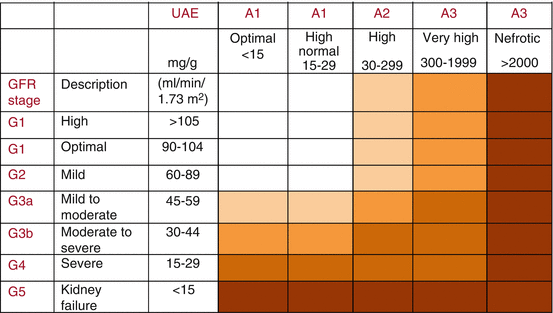Fig. 15.1
Relationship between serum creatinine, glomerular filtration rate, creatinine clearance, and stages of CKD
Recently, serum levels of cystatin C, a free housekeeping protein ubiquitous in many cellular systems, seem to be superior in reflecting not only the GF but also the CVD risk, mainly in the elderly [6]. Its utility in estimating kidney function derives from the fact that after being freely filtered in the glomerulus, it is then absorbed in the kidney tubules where it is fully degraded locally. There is no active tubular secretion or significant extrarenal elimination, making it an excellent marker of GFR. Cystatin C may also be superior to creatinine as a better predictor of cardiovascular mortality while providing a more accurate estimation of GFR. The serum cystatin C concentration is independent of muscle mass, nutritional status, and sex, although it may be altered in patients with derangements in thyroid function and certain cancers and with glucocorticoid therapy.
The widespread use of equations to calculate GFR has enabled the influence of renal function in cardiovascular risk to be assessed. The calculation was initially performed by the Cockcroft-Gault formula, which includes data on serum creatinine, age, sex, and weight, providing an estimation of creatinine clearance. The MDRD formula, which only needs serum creatinine, age, and sex, estimates the GFR. Both methods provide GF referred to mL/min/1.73 m2. Several studies have examined the difference between these methods compared to the corresponding gold standard – i.e., GFR calculated by isotopic techniques. In the range of normal values, with true GFR >60 ml/min, the GFR may be underestimated by up to 28 % when applying the formula [7]. As true glomerular filtration decreases, the differences between the methods become smaller – reaching an underestimation of 6 % when the true GFR is <30 ml/min [7]. The original equation to estimate GFR, which was published in 1996, has been constantly refined to improve its use in the general population. A recent updated equation, the CKD-EPI equation, corrects for much of the overestimation of CKD especially among those with GFRs between 60 and 89 mL/min/1.73 m2, mainly in female and black populations. The formula has also been adapted for other ethnicities, in particular of Asian origin (formulas and automatic calculators are available at www.kidney.org/professionals/kdoqi/gfr_calculator.cfm). It is worthy to remember that these equations should not be used in situations in which renal function is changing rapidly, such as in acute kidney injury. Likewise, they should be used with caution in subjects with extreme body mass since they underestimate in vey muscular patients and overestimate in very small patients.
15.2.1 Definitions
According to the estimated GFR (eGFR), five different stages of chronic kidney disease (CKD) have been defined (see Fig. 15.2) [8]. Stages 3 and higher are those in which CV risk is most pronounced, and within that stage, the risk is particularly elevated in those patients with stage 3b, i.e., eGFR < 45 mL/min/1.73 m2. This fact does not impede the recognition that in less advanced degrees of CKD, an elevated CV mortality has been described. Potential sources of bias include ascertainment problems, intra-patient variation in renal function, single eGFR which is likely to overestimate prevalence, and intra-laboratory variation: the use of raw creatinine to calculate eGFR does not take into account calibration issues between labs.


Fig. 15.2
Cardiovascular and renal risk based on eGFR and UAE
It is worthy to remember that in evaluating CVD using renal parameters, GFR should be assessed simultaneously with urinary albumin excretion (UAE). The presence of eGFR stage 3 or more and the presence of or an increase in urinary albumin or protein excretion are criteria for CKD. Chronic kidney disease (CKD) is frequently observed in arterial hypertension and is accompanied by a significant enhancement in CV risk that reinforces the need for simultaneous protection of both the renal and the CV system.
15.3 Prevalence
Prevalence of eGFR in levels of 60 or lower is frequent, but it is difficult to estimate since age is an important determinant, as well as sex, hypertension, obesity, and abnormalities in the glucose metabolism. In the general population, several studies have found that around 5 % of the subjects have GFR <60 ml/min/1.73 m2. In hypertension, one study conducted by our group including 6,227 hypertensive subjects from primary care and using the MDRD equation, renal insufficiency (GFR <60 ml/min/1.73 m2) was present in 21.8 % of the subjects, and 4.8 % subjects had a GFR ≤ 45 ml/min/1.73 m2 [9]. Subjects with the lowest GFR were more frequently older patients, women, and diabetics [10].
Stay updated, free articles. Join our Telegram channel

Full access? Get Clinical Tree


